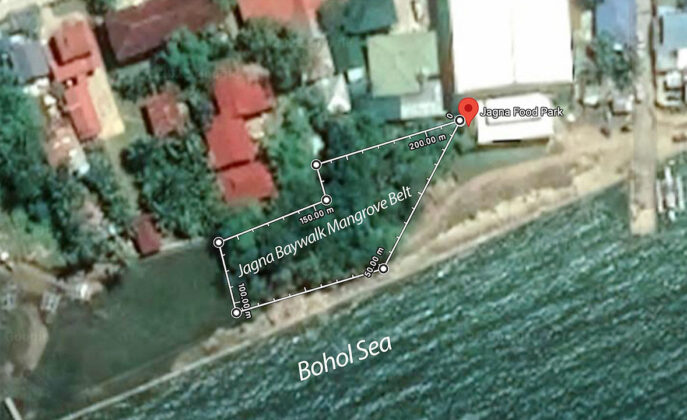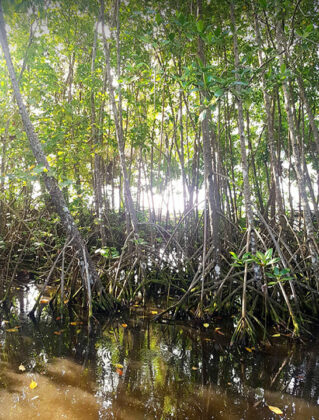The Jagna Baywalk Mangrove Belt and Mayor Joseph Rañola
Home Editors’ Picks The Jagna Baywalk Mangrove Belt and Mayor Joseph Rañola
The Jagna Baywalk Mangrove Belt and Mayor Joseph Rañola
August 14, 2022 4:56 pm

Introspective
Raul V. Fabella


Jagna is a port town located 63 kms east of Tagbilaran, Bohol, or 76.3 km from the newly constructed Panglao International Airport. It faces the Bohol Sea to the south, facing Mindanao, and is otherwise surrounded by mountains of lush green forest. A town in a great hurry in the last decade, it has attracted a McDonald’s fastfood restaurant, a 7-Eleven 24-hour convenience store, a mall and supermarket of the Bohol Quality chain, a brand-new Jagna Food Court, newly concreted side-roads, and end-to-end solar street lighting. The latter means that the “grid down episodes” common in Bohol no longer mean night darkness for Jagna-anons.
More importantly, Jagna hosts the justifiably renowned Central Visayan Institute Foundation (CVIF), home of the Dynamic Learning Program (DLP) which has produced singular learning outcomes in secondary education, defying the landscape of learning poverty lately documented by the 2018 PISA (Program for International Student Assessment) performance league table. The DLP, which has attracted adoption by over a hundred private and public high schools, is the brainchild of the dynamic physicist duo and Magsaysay awardees in education, Drs. Christopher Bernido and Maria Victoria Carpio-Bernido (may she rest in peace).
The municipality has an ambitious and ongoing building program which includes the scenic Jagna Baywalk which is also designed to serve as a concrete storm surge protection.
Leading the charge in this journey to an aborning progressive rural Philippines is newly re-elected Mayor Joseph Rañola. That he won his second term by a mere hundred votes says something of his peculiar approach to politics — he has a dim view of the traditional politics of pressing flesh and endless individual patronage. Rather, his philosophy seems to go: “Ang buhat ang pasultion” (“Let accomplishments do the talking.”). That is, provide public goods projects that serve all at once, like the solar street lighting, the new Sports Complex, newly concreted side roads, and the Jagna Baywalk. As we go into the Mandanas era of a higher local government share in central government tax revenues, this is the type of local governance that re-assures us that the new revenue flows will not be squandered. It is, however, rather rare and is not without its pitfalls.
The ongoing construction of the Jagna Baywalk threatens to block access to the sea of a beautiful patch of mangroves. Being blocked from seawater access means a death sentence to any mangrove patch. Our position is that the Jagna Baywalk itself would be more effective and in keeping with Bohol’s green image if conjoined with a lush mangrove belt, the Jagna Baywalk Mangrove Belt.
Mangrove forests have suffered massive degradation in the Philippines and elsewhere due primarily to land-use change such as fishponds, resorts, and infrastructure development. But mangroves are hugely useful to humanity and Boholanos: they serve as a buffer against storm surges, as a nursery for fingerlings, as a home for crustaceans, and as a lush aviary. More apropos in this climate change era, they also sequester carbon that otherwise would aggravate global warming.
This Jagna Baywalk Mangrove Belt covers an area of 1,658 sq.m. of robust pagatpat and statuesque bakawan mangrove species. This tiny patch serves as a sink for about 22 tons of carbon stock or about 82 tons of carbon dioxide. The contribution is small by itself, but multiplied a million times it could mitigate the global climate imbalance. It served precisely as a shelter against the December 2021 storm Odette — exactly as Dr. Jurgenne Primavera’s “Greenbelt Initiative” envisioned. This also serves as an advance guard of the “concrete action” extension of National Academy of Science and Technology’s (NAST) Pagtanaw 2040. The nice thing is that mangrove greenbelts regenerate themselves quickly and beautifully, pushing back on the Second Law of Thermodynamics, while concrete walls do not. Resilience dictates that while we resort to concrete for quick results, surge protection is most effective and lasting when buttressed by nature itself, thus, mangroves.
To this effect, Dr. Christopher Bernido had written to Mayor Rañola about the fate of the Jagna Baywalk Mangrove Belt. The mayor in turn called an all-stakeholders meeting: himself presiding, ourselves, his development staff, the private contractor, and the local branch of the DPWH (Department of Public Works and Highways) in a freewheeling discussion of the issue.
It turns out there was a strong generalized awareness about mangrove protection but especially from the mayor himself. Having grown up in these parts, the mayor revealed that this patch was originally planted by Chris’ own parents, then Governor Esteban Bernido and Consuelo Bernido. It was agreed that a substantial canal be explicitly provided in the plan and maintained to permanently connect the mangrove patch with the sea. It is important that there is a continuing exchange of plant and fish life between the sea and the mangrove patch. Now adjacent to the mangrove patch is an open brackish water shore area perfect for the expansion of mangrove belt. The Jagna Mangrove Belt will best serve a better surge protection if extended unto this brackish shore space.
Upon ocular inspection, however, it appears that the dike being constructed suggests a creeping land reclamation project on top of the storm surge protection. The construction work, advertently or otherwise, now threatens to overrun the empty space ideal for mangrove reforestation. This open space has experienced reforestation efforts by private groups but which have not yet borne fruit and require local government reaffirmation.
In Panglao Island, Bohol, the provincial government under then Governor Edgar Chatto simply rejected the business community’s proposal to reclaim a portion of the sea as it would annihilate a very important mangrove forest. This was then a signal victory for Green Bohol. We are confident that Jagna Mayor Joseph Rañola will ensure that the Jagna Baywalk Mangrove Belt will become yet another signal victory for Green Bohol.
The battle for Mother Earth has to be fought and won one square meter at a time.
Raul V. Fabella is a retired professor of the UP School of Economics, a member of the National Academy of Science and Technology and an honorary professor of the Asian Institute of Management. He gets his dopamine fix from bicycling and tending flowers with wife Teena.
